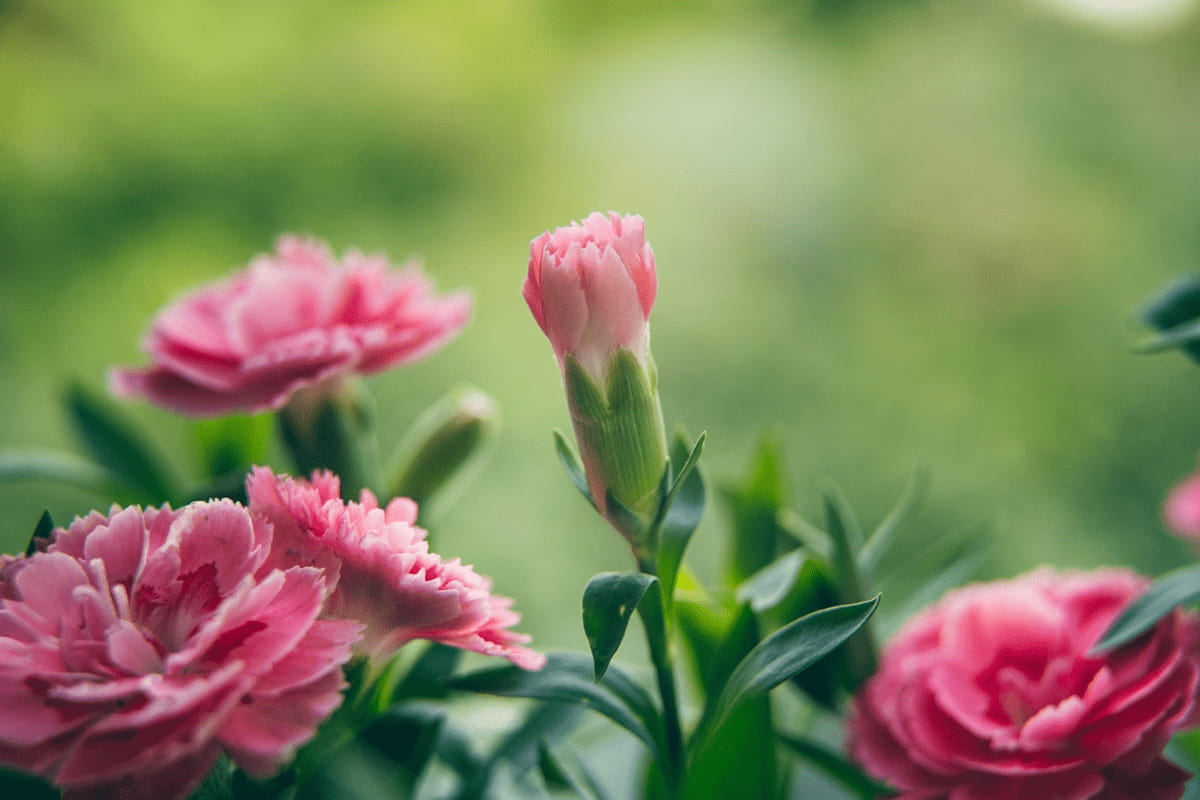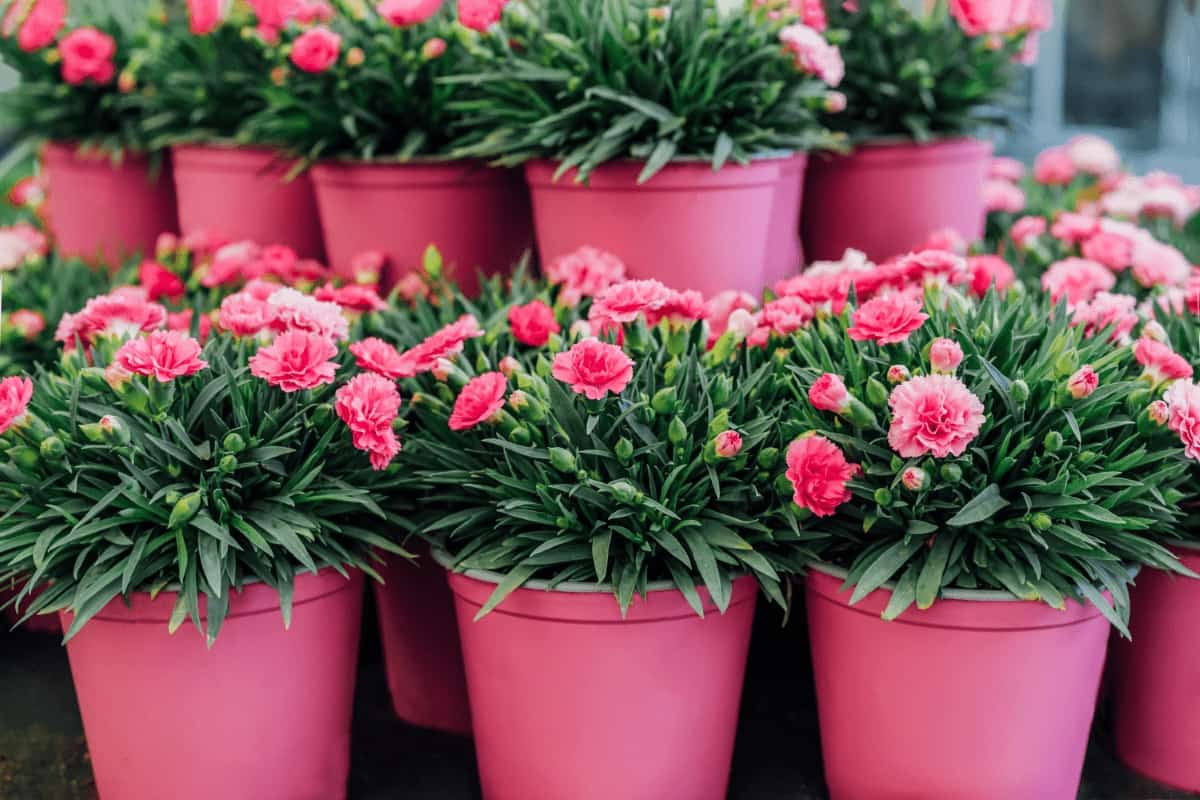Carnation flowers, also known as Dianthus caryophyllus, are popular among gardeners due to their beautiful appearance and pleasant fragrance. Beginners can grow them easily, making them an excellent choice. Here are some instructions to help you plant, grow, and care for your carnation flowers:

How to Plant and Care for Carnation Flowers
Step-By-Step Guide to Planting Carnation Flowers in Your Garden
- Choose a location with well-draining soil and at least six hours of sunlight daily.
- Prepare the planting spot by removing any weeds or debris and loosening the soil to a depth of 12 inches.
- Add organic matter like vermicompost or well-aged manure for improved fertility and drainage.
- Ensure that the hole is twice the depth and width of the plant’s root ball.
- Carefully remove the plant from its container without damaging its roots.
- Place the plant in the hole and backfill it with soil, pressing gently to eliminate air pockets.
- Water the plant thoroughly, ensuring the soil is evenly moist but not soggy.
- Apply a layer of mulch around the plant’s base to retain moisture and suppress weeds.
- Ensure the plant establishes well during the first few weeks and water as needed.
- A balanced fertilizer needs to be applied every four to six weeks during the growing season.
Choosing the Right Soil and Location for Planting Carnation Flowers
Soil
- A well-draining soil is essential for carnations. Too much moisture in the soil around the plant will cause the roots to rot.
- The ideal soil pH for carnations is between 6.0 and 6.5. If the soil is too acidic or alkaline, the plant may not thrive.
- Carnations prefer soil that is rich in organic matter. Amend the soil with vermicompost or well-rotted manure to improve quality.
Location
- Carnations require full sun to grow well. Choose a spot where it gets at least 6 hours of direct sunlight daily.
- The location should be sheltered from strong winds, as this can damage the delicate flowers.
- You should choose a location that receives some shade during the afternoon if you live in a warm climate.
Watering Techniques for Healthy and Vibrant Carnation Blooms
- Soil Moisture: Moisture must be maintained in the soil, but it must not be wet. Wilting and death can result from overwatering, which causes root rot. On the other hand, underwatering can cause the flowers to wilt and turn brown. The ideal soil moisture is damp to the touch but not soggy.
- Watering Schedule: Carnations require regular watering to ensure healthy blooms. Watering should be done at least once a week and more frequently during hot and dry weather.
- Watering Techniques: Carnations are best watered at the base instead of on their leaves and flowers. A fungal infection can be prevented by doing this.
- Water Quality: The water quality used for watering is also essential. Carnations prefer slightly acidic soil, so rainwater or distilled water is ideal. If using tap water, let it sit out for a day or two to allow the chlorine to dissipate.
Growing Carnation Flowers from Seeds: A Beginner’s Tutorial
- Choose A Good Location: Carnations prefer full sun to partial shade, so choose a location with plenty of sunlight. The soil should be well-draining and rich in nutrients.
- Start Seeds Indoors: Approximately 8-10 weeks before the last frost date in your area, start your seeds indoors. The seeds need to be planted about 1/8 inch deep in a seed-starting mix. Maintain moist but not waterlogged soil.
- Transplant Seedlings: They can be transplanted directly into the garden or larger pots once they are about 2-3 inches tall. Ensure the soil drains well and the plants have enough space to grow.
- Water Regularly: Carnations need regular watering, especially during hot and dry weather. Water deeply once a week or more often if the soil feels dry.
- Fertilize Monthly: Use a balanced fertilizer once a month to keep your carnations healthy and strong.
- Deadhead Regularly: Plants with spent flowers should be removed to encourage more blooms and prevent them from going to seed too soon.
- Protect From Pests: Look for pests like aphids and spider mites, and treat them promptly to prevent plant damage.
In case you missed it: The Best Fertilizer for Carnations: When and How to Apply

Pruning and Deadheading Carnation Flowers for Prolonged Flowering
You should use sharp, clean scissors to cut away dead, damaged, or diseased leaves and stems to prune carnations. Remove the branches growing in the wrong direction or crossing over each other. Plants maintain a healthy shape and promote the growth of new shoots by doing this.
Deadheading carnations is another important technique for prolonging the flowering period. This involves removing the faded flowers as soon as they start to wilt. To do this, pinch off the flower stem just below the base of the flower. This stimulates the plant to produce new buds and flowers, keeping the plant looking fresh and vibrant.
Protecting Carnation Flowers from Common Pests and Diseases
Pests
- Aphids: The best way to prevent aphids is to keep the plants healthy by providing sufficient water and nutrients. If aphids are already present, spray the plants with water and dish soap or use insecticidal soap.
- Spider mites: You can protect your plants from spider mites by regularly misting them with water and keeping the air around them humid. Apply insecticidal soap or neem oil to kill spider mites.
- Thrips: Use yellow sticky traps or insecticidal soap to protect your plants from thrips.
Diseases
The most common fungal diseases are gray mold and powdery mildew. Gray mold can be prevented by keeping the plants dry and avoiding overcrowding. Powdery mildew can be prevented by providing good air circulation and avoiding overhead watering. You can use a fungicide to control the disease if your plants are already infected. Bacterial wilt is another disease that can affect carnationsYou can prevent bacterial wilt by avoiding overwatering and ensuring good drainage. If your plants are already infected, remove them from the garden and destroy them to prevent the disease from spreading.
Fertilizing Carnation Plants: Nutrient Requirements and Feeding Schedule
Nutrient Requirements
Carnation plants require a balanced supply of essential nutrients for optimal growth. The primary macronutrients include nitrogen, phosphorus, and potassium. Nitrogen is essential for vegetative growth, and phosphorus promotes root development and flowering, and potassium aids in disease resistance and stress tolerance. Secondary macronutrients, such as calcium, magnesium, and sulfur, are also necessary in smaller amounts. Lastly, micronutrients, including iron, manganese, and zinc, are required for proper plant development and function.
Feeding Schedule
Carnation plants should be fertilized regularly throughout the growing season, typically from spring to fall. The feeding schedule depends on the type of fertilizer used and the plant’s growth stage. A general guideline is to fertilize every 2-3 weeks with a balanced fertilizer (10-10-10 or 20-20-20 formula) during the vegetative stage. Once the plant enters the flowering stage, switch to a high-phosphorus fertilizer, such as a 5-10-5 or 10-20-10 formula, to promote flower production.
Understanding the Blooming Season of Carnation Flowers
Carnations typically bloom in late spring to early summer, depending on the climate and location. In colder regions, they may bloom later in the summer. The blooming season of carnations typically lasts for several weeks, with individual flowers lasting up to two weeks.
It is important to note that not all carnation plants bloom simultaneously. Some may bloom earlier or later than others, based on factors such as soil conditions and amount of sunlight exposure. Additionally, certain varieties of carnations may have different blooming seasons, with some blooming in the fall or winter.
Overwintering Carnation Flowers: Winter Care and Protection
- Preparing your Carnation Flowers for Winter: Before the first frost, prepare your carnation flowers for winter by cutting them back to about 4-6 inches in height. This will prevent damage to the plant during the winter months.
- Mulching your Carnation Flowers: After cutting back your carnation flowers, apply a layer of mulch around the plant’s base. Use high-quality mulch such as shredded leaves, straw, or wood chips.
- Protecting your Carnation Flowers from Snow and Ice: Cover the Carnation plants with a row cover or burlap. This prevents damage to the plant and protects it from the cold.
- Watering your Carnation Flowers: Keeping your Carnation flowers hydrated during the winter months is important. Water your plants once a week or when the soil feels dry.
- Checking on your Carnation Flowers: Throughout the winter, checking on your Carnation flowers periodically ensures they are healthy and protected. Look for signs of damage or disease and address any issues immediately.
In case you missed it: How to Grow Carnations in a Greenhouse: A Step-By-Step Guide for Planting to Harvest

Conclusion
Following these instructions, you can easily plant, grow, and care for carnation flowers, even if you’re a beginner. Carnation flowers will surely add beauty to any garden with their beautiful blooms and sweet fragrance.
- Feed Your Flock for Less: Top 10 Tips to Save on Chicken Feed
- Ultimate Guide to Ossabaw Island Hog: Breeding, Raising, Diet, and Care
- Hatching Answers: The Top 10 Reasons Your Chickens Aren’t Laying Eggs
- Eggs and Economics: Breaking Down the Cost of Raising Backyard Chickens
- Defend Your Greens: Proven Methods to Keep Iguanas Out of Your Garden
- Ultimate Guide to Cinnamon Queen Chicken: A Comprehensive Guide for Beginners
- Ultimate Guide to California Tan Chicken: Breeding, Raising, Diet, Egg-Production and Care
- Ultimate Guide to Marsh Daisy Chicken: Breeding, Raising, Diet, and Care
- 10 Types of Chicken Farming Businesses You Can Start for Profits